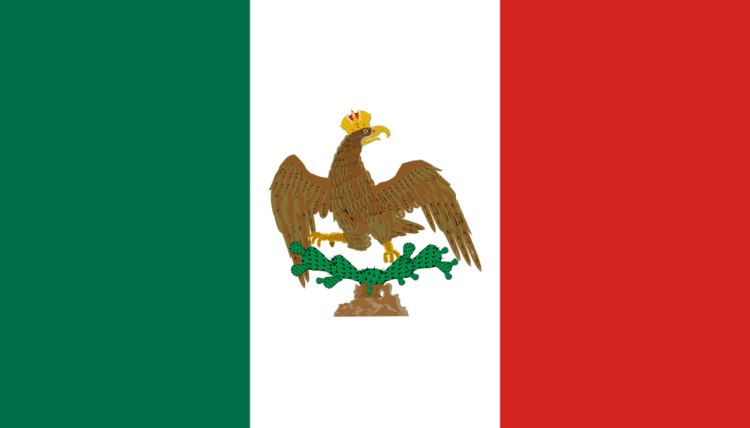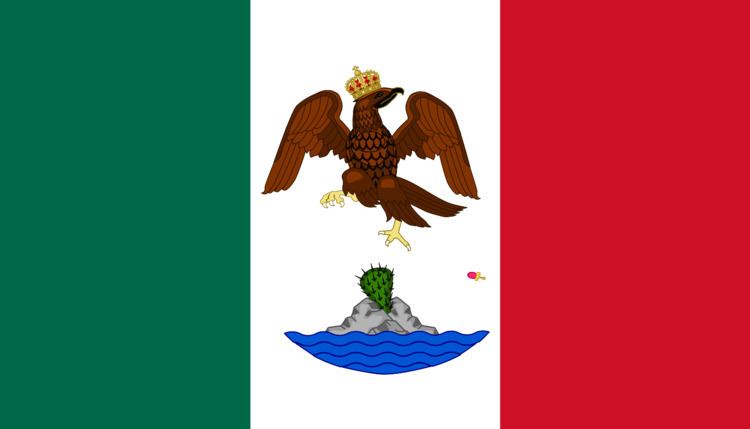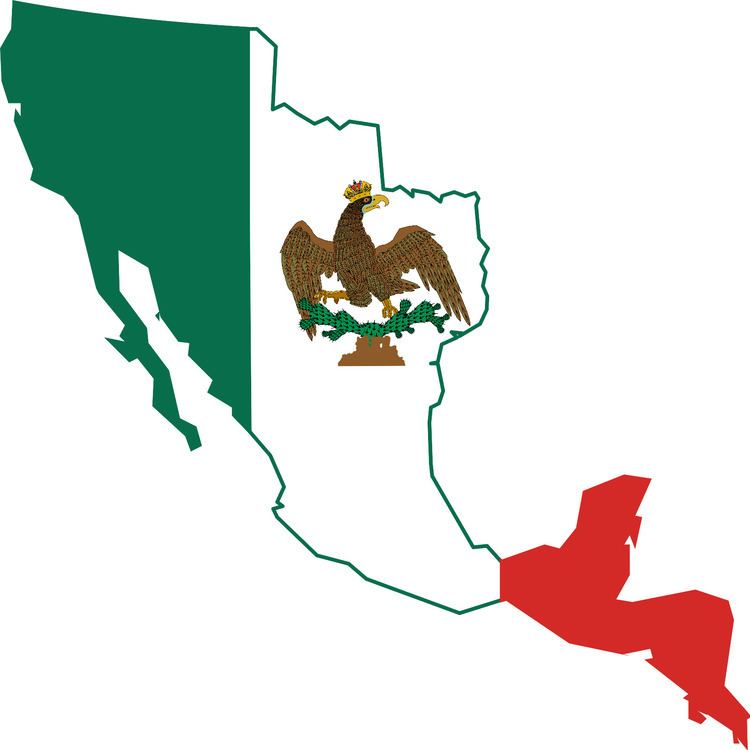1822–1823 Agustín I 1822 Nicolás Bravo Rueda Founded 1821 Date dissolved 1823 | Religion Roman Catholicism 1821–1822 Agustín de Iturbide | |
 | ||
Government Constitutional Monarchy | ||
The Mexican Empire (Spanish: Imperio Mexicano) was a short-lived monarchy and the first independent post-colonial state in Mexico. It was the only former colony of the Spanish Empire to establish a monarchy after independence and for a short time, together with the Empire of Brazil, it was one of two empires in the Americas. The First Mexican Empire was short-lived, lasting less than two years.
Contents
- The first mexican empire every year
- Creation
- Iturbide
- Collapse
- Territory
- Political subdivisions
- References

It existed from the signing of the Treaty of Córdoba and the declaration of Independence of the Mexican Empire in September 1821 until the emperor's abdication in March 1823 when the Provisional Government took the power and the First Mexican Republic was proclaimed in 1824. The first and only monarch of the state was Agustín de Iturbide, reigning as Agustín I of Mexico, for less than eight months. The empire was briefly reestablished by the French in 1864.

The first mexican empire every year
Creation

The various independentist factions in revolutionary Mexico coalesced around three principles, or "guarantees," for Mexican independence from Spain: that Mexico would be an independent constitutional monarchy governed by a conservative European prince; that criollos and peninsulares would henceforth enjoy equal rights and privileges; and that the Roman Catholic Church would retain its privileges and position as the official religion of the land. These Three Guarantees formed the core of the Plan of Iguala, the revolutionary blueprint which, by combining the goal of independence and a constitution with the preservation of Catholic monarchy, brought together all Mexican factions. Under the 24 February 1821 Plan of Iguala, to which most of the provinces subscribed, the Mexican Congress established a regency council which was headed by Iturbide.

After signing the Declaration of Independence of the Mexican Empire of 28 September 1821, the Mexican Congress intended to establish a commonwealth whereby the King of Spain, Ferdinand VII, would also be emperor of Mexico, and both countries would be governed by separate laws and form separate legislative bodies. If the king refused the position, the law provided for another member of the House of Bourbon to accede to the Mexican throne. However, the goal was merely a political tactic to appease the last royalists, and a full independence was expected. King Ferdinand, however, refused to recognize Mexico's independence and said that Spain would not allow any other European prince to take the throne of Mexico.
Iturbide

General Agustín de Iturbide, a Mexican criollo who had been a royalist officer, led the Army of the Three Guarantees in the final phases of the war, was elected head of the provisional government and of the regency which held the imperial power while a monarch was chosen. Iturbide was extremely popular after his successes in the war of independence, and in the evening of 18 May 1822 a mass demonstration led by the Regiment of Celaya, which Iturbide had commanded during the war, marched through the streets of Mexico City and demanded that their commander-in-chief accept the throne himself.
On 19 May 1822, Mexican Congress named Iturbide as a constitutional emperor. On 21 May it issued a decree confirming this appointment, which was officially a temporary measure until a European monarch could be found to rule Mexico. Iturbide's official title was, "By Divine Providence and the National Congress, First Constitutional Emperor of Mexico" (Spanish: Por la Divina Providencia y por el Congreso de la Nación, Primer Emperador Constitucional de México). His coronation took place on 21 July 1822 in Mexico City.
In August 1822 a plot to overthrow the monarchy was discovered and on August 25, plotters, including 16 members of Congress, were arrested. As factions in the Congress began to sharply criticise Iturbide and his policies, the emperor decided on 31 October to dissolve the body. This led to provincial uprisings, the most important of which was in the garrison at Veracruz led by Antonio López de Santa Anna, who would later be president of Mexico during the secession of Texas and the disastrous Mexican–American War. Santa Anna and his troops revolted against Iturbide, calling for the restoration of the Congress on 1 December 1822. Santa Anna had secretly persuaded General Echávarri, the commander of the Imperial forces, to switch sides and support the revolution when it was ready to be proclaimed throughout Mexico. The independence heroes Vicente Guerrero, Nicolás Bravo and Guadalupe Victoria soon joined, signing the Plan of Casa Mata on February 1, 1823, which called for the restoration of the Congress.
Collapse
The Plan of Casa Mata, which other Mexican generals, governors, and high-ranking governmental officials soon signed, did not recognize the First Mexican Empire and called for the convening of a new Constituent Congress. The insurrectionists sent their proposal to the provincial governments and requested their adherence to the plan. In the course of just six weeks, the Plan of Casa Mata traveled to such remote places as Texas, and almost all the provinces supported the plan.
Each provincial government that accepted the plan thereby withdrew its allegiance from the Imperial government and assumed sovereignty within its own province.
This left Emperor Agustín I isolated with little support outside of Mexico City and a few factions of the Imperial Army. Consequently, he reinstalled the Congress, which he had previously abolished, abdicated the throne, and fled the country on 19 March 1823.
Santa Anna and the other proponents of the Plan of Casa Mata went on to oversee the drafting of a new constitution and the establishment of the First Mexican Republic the following year.
Territory
The territory of the Mexican Empire corresponded to the borders of Viceroyalty of New Spain, excluding the Captaincies General of Cuba, Santo Domingo and the Philippines. The Central American lands of the former Captaincy General of Guatemala were annexed to the Empire shortly after its establishment, making the First Mexican Empire the largest country in North America with territory of 4,5 million square km.
Under the First Empire, Mexico reached its greatest territorial extent, stretching from northern California to the provinces of Central America (excluding Panama, which was then part of Colombia), which had not initially approved becoming part of the Mexican Empire but joined the Empire shortly after their independence.
After the emperor abdicated, on March 29 the departing Mexican general Vicente Filisola called for a new Central American Congress to convene and on July 1, 1823 the Central American provinces formed the Federal Republic of Central America, with only the province of Chiapas choosing to remain a part of Mexico as a state. Subsequent territorial evolution of Mexico over the next several decades (principally to the United States) would eventually reduce Mexico to less than half its maximum extent.
Political subdivisions
The first Mexican empire was divided into the following intendances:
